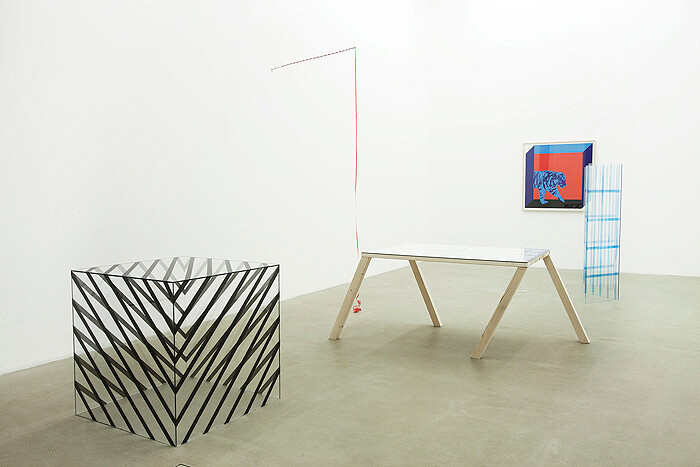Blame it on Pippi Longstocking and a 70s-style, girl-power upbringing, but as a kid I too dreamt of living alone with a clever white horse called Old Man whom I could lift up with a finger. I refused to take too seriously the circus of adults who pretended to have a say about me. The idea of being boxed in by rules was insufferable. All those riotous feelings came back with a bang while visiting Judith Hopf’s solo show at kaufmann repetto, her first in Italy. Hopf’s evocation of horses and tigers—however tame or ironic—prompted an instinctive longing for freedom, a longing from all the prescriptive grammars of seeing and reacting to Art. An allergy to orders is, I guess, one of the reasons why the world of (caged, trained) animals is often such a sensitive subject for women artists—I could draw a long list here, from the great 19th century animalière painter Rosa Bonheur to Simone Forti’s choreographies inspired by her observations at the zoo, and Rosemarie Trockel, with her raucous motto, “Every animal is a female artist,” as a provocative response to Beuys’s “Jeder Mensch [ist] ein Künstler.”
What I found most enticing, however, is that Hopf stages her role as an artist dominatrix and master of ceremonies with a good deal of ambiguity by replacing the strings of her whips with colored streamers (Untitled (kleine peitsche rot, blau), 2009; Untitled (kleine peitsche rot, rosa, hellblau), 2009), which makes me uncertain whether that sudden blast of juvenile anger wasn’t a well-performed capriole, induced by the artist’s soft crack. Equitation, after all, is a theme Hopf works with frequently. In the tiny project room of the gallery, one finds Zählen! (Count!, 2008), a video where the artist, dressed up like an amazon, stands by her horse, while he is asked to prove he can count by a grotesque crowd of clowns. The video alludes to the story of Clever Hans, a trained animal who, in Germany, at the beginning of 20th century, had learned how to perform basic arithmetic tasks by reacting to the emotional behavior of his human public.
The exhibition layout is an exercise in neatness and sequential parcour, as if the gallery had been turned into an equestrian arena for dressage, the sport which tests the ability of a horse and rider “to perform from memory a series of predetermined movements”; the more natural and relaxed they look, the higher the score. Hopf plays with the symmetry of the gallery’s architecture, which is divided into two white cubes on either side of the central entrance. As in a spot-the-difference game, similar works have been installed in identical positions in both rooms, so that viewers are forced to pace back and forth inside the space—the “evenly lighted cell,” to quote Brian O’Doherty’s infamous definition, where “art is free, as the saying used to go, ‘to take on its own life’.”
At the center of each back wall hangs a visual puzzle in bold shades of cyan, blue, and red. In the room on the left, the work A Sudden Walk 1 (2012) shows a tiger entering the frame; in the room on the right, A Sudden Walk 2 (2012) depicts the tiger walking out of it. The invitation card too makes clever reference to this tiger on the go, but here Hopf left the cage empty, with two broken bars to indicate a tiger on the loose. All the three graphic versions share the same “kinetic” cage-cum-frame, a 3-D optical illusion. Other twin works, two formalist sculptures, both made of glass, are Cage Cube 1 (2012) and Cage Cube 2 (2012): seen from the right perspective, the stripes of tape on their surface crisscross so that the title becomes obvious. The middle of each room is occupied by a collaborative work with Florian Zeyfang, two tables whose diagonal legs recall an animal’s stride: on top of Walking Table (2012) and Walking Table 2 (2012), one finds a series of paper monoprints where the Fibonacci sequence (the so-called “formula of nature,” which regulates the growth of plants and reproductive patterns of animals) is marked out by a horse’s hoof—potentially that of a more Clever Hans, one presumes.
The exhibition’s title, “A Sudden Walk,” is taken from a Kafka story celebrating the pleasures of an evening walk, with “your limbs responding with particular agility to the unexpected freedom you have procured for them.” But I was reminded instead of Kafka’s “A Hunger Artist,” a story that revolves around training, cages, and the side effects of the spectacle. It’s the tale of a profession most strange, that of a “professional faster,” who, after touring cities and theaters to great acclaim, locked up in a cage to prevent himself from eating, falls out of fashion and ends up in a circus, forgotten to the point that he fasts so much, he dies. “Into the cage they put a young panther,” Kafka writes. “His noble body, furnished almost to the bursting point with all that it needed, seemed to carry freedom around with it too (…) and the joy of life streamed with such ardent passion from his throat that for the onlookers it was not easy to stand the shock of it. But they braced themselves, crowded around the cage, and did not ever want to move away.” What does it take to please a “learned” public? How many new panthers or tigers (or horses) will we have to lift a finger to before we consider the possibility of a sudden walk out? Hoopla.




